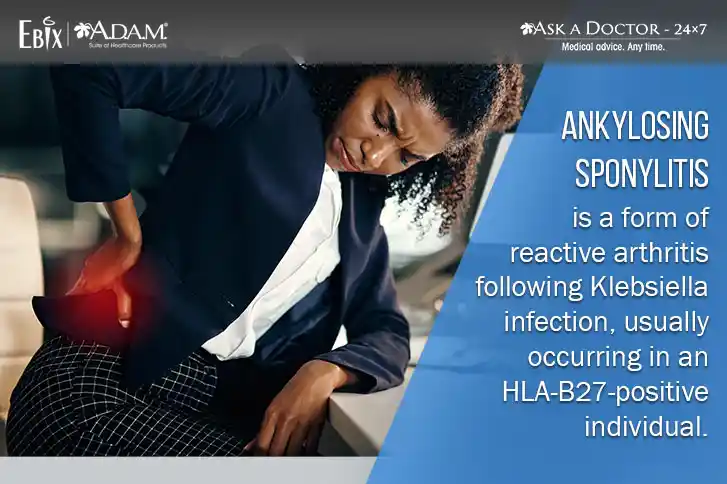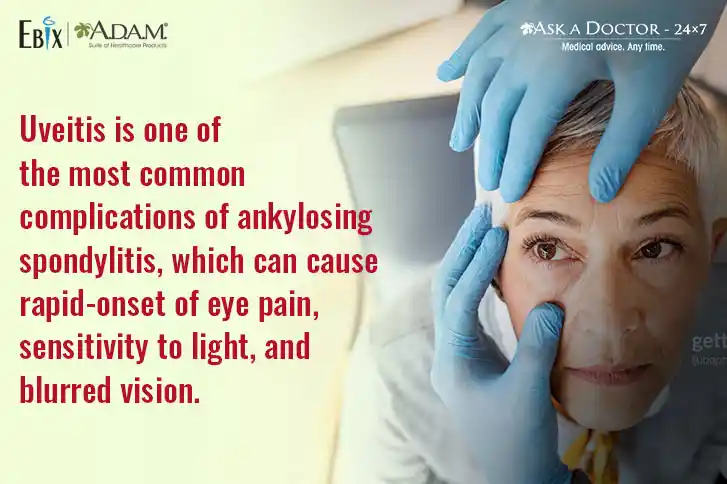What Is Ankylosing Spondylitis, Its Causes And Treatment
Ankylosing Spondylitis is a form of inflammatory arthritis that affects the bones of the spine (vertebrae) and joints in the lower back. This disease is mostly observed among adolescents or adults, between the ages of 17 years to 45 years.
Initially, an inflammation in the joints between the pelvic bones and the base of the spine is noted. This inflammation then gradually spreads to joints between the vertebrae leading to spondylitis. Over time, the bones of the vertebrae may fuse (Ankylosis), causing restrictive back movement.
As the disease progresses, the joints between the ribs and the spine may also get affected and one could suffer from breathing difficulty.
Identify the Causes of Ankylosing Spondylitis

Though the exact cause of developing AS is not yet known, multiple genetic and environmental factors likely play a part in determining the risk of developing this disorder. Researchers have identified some genes that may be responsible for the risk of AS. Variations of HLA-B, ERAP1, IL1A, and IL23R genes are associated with AS.
Among these, a variation of the HLA-B gene called HLA-B27 is found in 8 out of 10 people with AS.
Symptoms Associated With Ankylosing Spondylitis

If you have AS, you may suffer from one or more of the following symptoms:
- Back pain and stiffness: Due to AS one may experience excruciating back pain and stiffness that worsens in the morning and at mid-night. You may also experience pain around the buttocks.
- Arthritis: Apart from inflammation of the spine, AS may cause inflammation in other joints like your knees and hips. You may experience pain while moving the affected joint. There may be swelling, tenderness, and warmth in the affected joint area. You can ask an online rheumatologist for more information about arthritis and its association with AS.
- Fatigue is another of the most common complaints among ankylosing spondylitis patients.
Note that initially, these symptoms may be mild, but over some time, they might become worse. You could also experience intermittent periods of flare-ups and remission.
Possible Complications Associated with Ankylosing Spondylitis

If proper disease management strategies are not adopted, then AS may lead to several complications, like:
- Joint damage: Constant inflammation of your hip or knee joints can damage these joints permanently over time. This can affect your mobility and may even necessitate joint replacement surgery.
- Reduced flexibility: If the bones in the lower spine fuse together, it can severely restrict your spine movement. Sometimes surgery is the only solution to correct severe bends in the spine.
- Iritis: It is a condition where the eye turns red, swollen, and painful. Usually, only one of your eyes will get affected. This condition needs to be treated urgently by an eye specialist as it can lead to loss of vision. Book an online consultation with an ophthalmologist, in case you can notice alike symptoms.
In addition to the above, AS can also cause backbone fractures, compressed nerves at the bottom of the spine resulting in pain and numbness in the region, weakness in the legs, and an inability to control the bladder or bowels (urinary or bowel incontinence).
Diagnosing Ankylosing Spondylitis

If you suffer from chronic back pain that does not get better with rest and worsens in the morning or during the night, then you must consult a physician without further delay. Based on your symptoms, if the physician suspects AS, he might ask you to undergo some blood tests to check for signs of inflammation in your body.
If your reports are suggestive of inflammation, you will be referred to a specialist for further tests such as X-rays, MRI scans, or genetic testing for the HLA-B27 gene. Once confirmed, your doctor will start the treatment program.
Treatment Strategies for Ankylosing Spondylitis

You need to know that there is no cure for AS, and the treatment goal revolves around relieving symptoms through exercise, physiotherapy, and medications. Physiotherapy and exercise help to improve posture and range of spinal movement. They also can prevent or delay your spine from becoming stiff.
It is important to have a better understanding of AS because it can help you identify the disease and manage the condition adequately. Moreover, timely consultation with a healthcare specialist can reduce your risk of complications and improve your quality of life.
For more information on Ankylosing Spondylitis, speak to one of our online doctors today.
Ask a Specialist
Recent Questions


